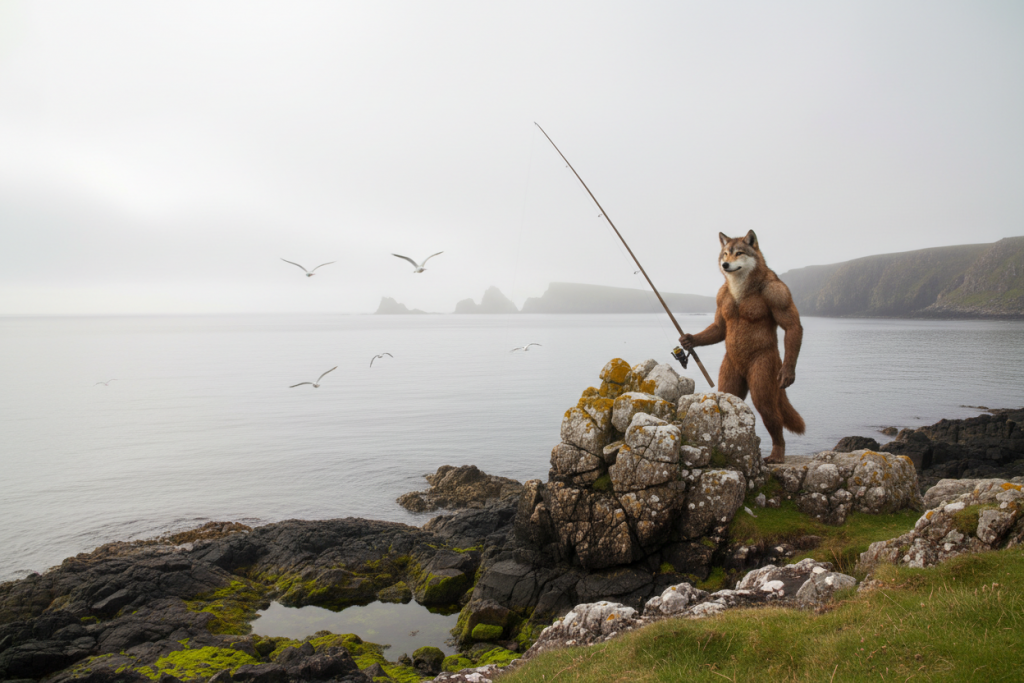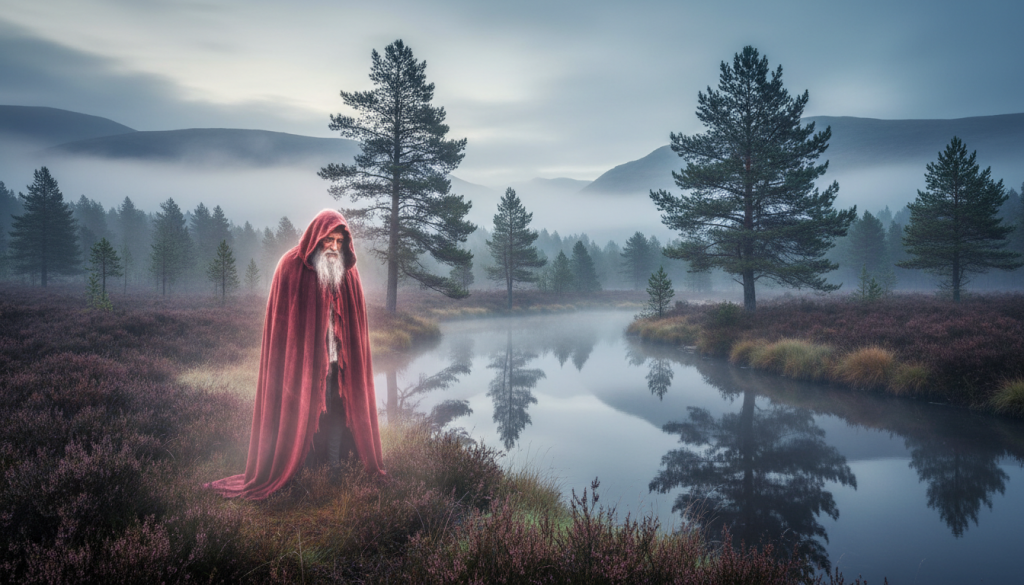General Information:
A hill giant of Aberdeenshire tradition, associated with Bennachie, a landmark hill rising over 1,700 feet. He is remembered as both a guardian and a rival, sometimes kindly, sometimes destructive, deeply tied to the shaping of the landscape.
Appearance:
Immense in stature — said to lie the length of 600 feet between two hilltops (“Little John’s Length”). Often imagined in human shape, of massive build, sometimes rustic and rough, but rarely monstrous in aspect.
Habitat:
Bennachie itself, especially the Mither Tap, Oxen Craig, and Craigshannoch. His “bed” stretches between two tors marking his size.
Behaviour:
- Throws vast boulders across valleys in contests with rival giants.
- Known to take offense at noise (monks, rivalries, gossip).
- Displayed fiercely protective loyalty to Lady Anne but prone to destructive rage.
- In some stories, kindly-disposed, even receiving gifts and living in uneasy truce with humans.
Shape-shifting Ability:
None explicit, though faeries shape-shift around him (notably the fairy disguised as Lady Anne). In some tales, Jock himself blends into the mountain, enchanted into slumber, almost becoming part of Bennachie.
Variant:
- The Stone Thrower: Rival of Jock o’ Noth, shaping the hilltops with missiles of granite.
- The Tragic Lover: Wooed Lady Anne, but killed her in the crossfire of a giant’s quarrel and was tricked by a fairy into eternal imprisonment.
- The Monastic Opponent: Disturbed by monks of Monymusk, he hurled a stone that was miraculously stayed mid-air by prayer and now rests in the River Don.
Location in Scotland:
Bennachie, Aberdeenshire, with legends stretching to Tap o’ Noth (Rhynie), Kemnay, and Monymusk.
Stories / Sightings or Experiences:
The tales of Jock o’ Bennachie are many, scattered across Aberdeenshire, and reveal the giant as warrior, lover, foe, victim of enchantment, and even reluctant neighbour to the monks of Monymusk. Together, they form one of the richest giant traditions in Scotland.
1. The Bed of the Giant — “Little John’s Length”
At Bennachie, the resting place of Jock is still pointed out. Known as Little John’s Length, it stretches an astonishing 600 feet between two tors near Craigshannoch. Tradition holds this to be the giant’s bed, as even one of his size required vast space. By lying the hilltops themselves flat with his body, Jock demonstrated his colossal form — a living explanation for the mountain’s shape.
2. Giant Rivalries — Jock o’ Bennachie and Jock o’ Noth
Jock’s most famous foe was Jock o’ Noth, the rival giant of Tap o’ Noth, thirteen miles away. The two are said to have hurled massive boulders back and forth between the mountains, the “missiles” leaving their marks across the land.
On Tap o’ Noth there is a stone bearing the imprint of five enormous fingers where Jock o’ Bennachie’s throw once landed — so the elders claim. At Bennachie’s Mither Tap a hollow gouge is still shown where a retaliatory boulder struck. To stand upon these sites is to walk within the battlefield of giants, where their contests were played out on a superhuman scale.
3. The Tragedy of Lady Anne
But it was not only rivalry that drove Jock — it was love. Both Bennachie’s Jock and Noth’s Jock sought the hand of Lady Anne, a beautiful giantess of the district. Gossip reached Jock of Bennachie that Lady Anne and his rival were seen together. Clambering to the heights of Oxen Craig, Jock saw them with his own hawk-like eyes — Anne and Jock o’ Noth embracing.
Enraged, he seized a granite boulder and hurled it at his rival. To his horror, in the scramble and confusion Lady Anne was struck by a flying stone and crushed upon the hillside. Jock’s howl of grief echoed across the valley. Fleeing in despair, he vanished into the woods, believing he had slain his beloved.
That night, heartsick and weeping, he thought he dreamt when Lady Anne appeared to him, radiant in white, arms outstretched, calling his name. “My bonnie darling,” she cried, “I am not dead!” Jock went to her gladly — only to see the image dissolve. It was no Anne, but a dreadful fairy-woman, ugly and wrathful, who trapped him in a cavern within the hill.
With her curse, she sealed Bennachie’s guardian in stone and darkness, declaring that Scotland would never know wealth until Jock was released. Only a one-eyed widow’s son, beneath a juniper tree, could find the lost key to open Bennachie and free him. To this day, Jock remains enchanted underground, his breathing said to stir the earth beneath walkers who pause on the summit.
4. The Monks of Monymusk
Another tale speaks not of love but of irritation. Jock, like all giants, valued his rest. When the monks of Monymusk rose for matins at 4am, their early chants carried across the valleys and disturbed his sleep. Unwilling to tolerate it any longer, Jock seized a massive stone and hurled it straight at their abbey.
Fortune, or providence, intervened. One sleepy monk, late for prayers, happened to be running across the cloister when he saw the rock in flight. He rushed ahead and warned the brethren. The monks fell to their knees and prayed fervently. The stone — already descending upon the church — is said to have halted in mid-air and hung there for a moment, before dropping harmlessly into the River Don.
The abbot, wise and diplomatic, sent gifts to Jock, begging his forbearance. A truce was struck, and the monks promised to sing more softly so that Bennachie’s giant could sleep. To this day, the great boulder is said to remain in the Don beside Monymusk House, a silent witness to the power of prayer over the rage of giants.
5. The Stones of Kemnay
In Kemnay and Greatstone, enormous granite boulders are shown to visitors and said to have been lobbed by Jock in one of his contests — at the priest of Kemnay, according to some traditions. Sizes of 20 to 21 feet in length, weighing untold tons, these stones are impossible for mortal hands to shift. Yet in local lore, they were Jock’s mere playthings.
Some versions accuse not Jock but the Devil himself — “the aul’ Smith” — of casting them. But in villagers’ minds, it is more fitting that they came from the fist of Aberdeenshire’s greatest giant, hurling his challenge across the countryside.
Purpose of the Myth or Legend:
- Explains the striking geology of Bennachie and nearby valleys (crags, boulders, landscape scars).
- Functions as a romantic tragedy (a giant’s doomed love for Lady Anne).
- Serves as a cautionary tale about rage, impulsivity, and the destructive consequences of giants’ feuds.
- Embeds Christian influence through miracle stories (the monks), aligning old giant lore with divine power.
- Keeps alive a sense of mystery around Bennachie — the enchanted slumber beneath the hill grants it a sacred or fateful aura.




